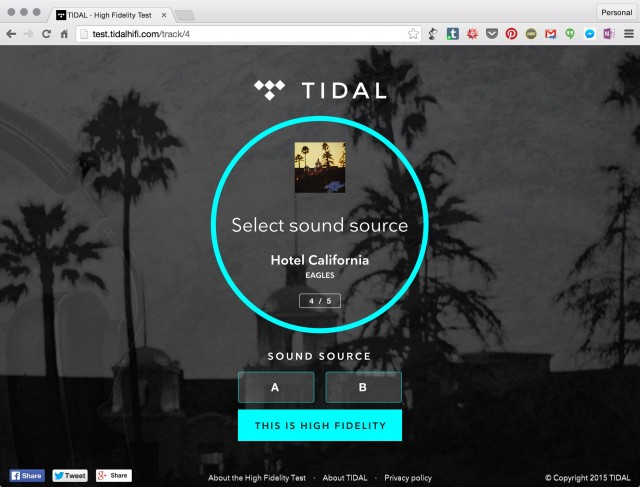So, in case you haven’t heard yet, there’s a new “hifi” streaming service called Tidal.
Don’t waste your time watching the weird press event with Madonna and Daft Punk, congratulating themselves like they’re at the Grammies. Don’t let yourself be mesmerized by the desaturated music video in which Jay Z’s friends all get together to drink champagne and talk about “making a stand.” Don’t worry about the European startup that made the tech, or sweat the pricing. Don’t even hand over your credit card in order to start a free trial.
No, the only thing you need to do is this:
1. Get your favorite pair of headphones or listening rig. (If you’re reading this site, I expect you have something decent.)
2. Go to http://test.tidalhifi.com/ and fire up the blind test.
Okay, optionally…
3. If you didn’t like the tracks they offered, you might also grab a friend. Sign up for two free trials – one with Hifi, one without. Open up different browser windows with the Hifi and non-Hifi accounts. Now, randomizing which is ‘a’ and which is ‘b’ (your friend will have to take notes).
There. You can even stop reading now if you want, because whatever conclusion you reach is the only one that matters.
And actually, if you really do prefer the higher quality in an A/B test and want to spend another ten bucks or ten Euros for it, great!
But if you want to go on…
Your BS meter should be going off just based on the text on the site. For instance, if you do correctly guess which is the more information-dense stream, you get a congratulatory message: “Five in five correct, fantastic! You have an ear for detail and a good audio system, it’s for people like you that we have created the service.” (Warning: you can successfully get 5 out of 5 at random – that’s just repeating a coin flip five times. So you might want to keep going.)
If you get them wrong, they cheekily ask if you’ve connected your equipment properly. More appropriate would be, if you continue to answer these five at a time and begin to near a random result of 50%, a message that concedes “Okay, great – so it turns out listening to stereo tracks with lossy compression produces an imperceptible difference and we should all really just relax!”
Here’s my take: if you’re struggling at all, even if you get the answers correct, you should really ask yourself whether this trouble is worth it. (As noted in comments, the track selection here isn’t really optimal, so you might want to try out #3 in my list above. But I’ve found similar research and tests with other content, too, at least when using 320 kbps AAC.)
Tidal isn’t just charging you more for the higher quality; you’re also consuming more bandwidth while using it. Buffering takes longer, even if you aren’t paying for that.
If Tidal’s claims are to be believed, in fact, you should be swept away by the results – think the Maxell man. (Illustration here. Also, note the copy. Remember, there was a time when we were having this argument about cassette tapes, which I think we can now all agree all sound universally terrible, if… entertainingly terrible. This argument is always framed by whomever is trying to sell a specific product.)
Don’t get me wrong: some streaming quality is pretty poor. Bandcamp, for instance, specifically limits the quality of streaming music. That makes sense – you’re trying to give a preview and compel your fans to buy the downloads. And SoundCloud is still poor enough that I’ve noticed lost fidelity in music, though I still rely on my music sounding good enough streaming there that I can earn bookings and so on. But if anything, what my “Hifi” experiments taught me was that 320 kbps AAC was what I should demand, because it sounds close enough to lossless as to make no difference. (For production, greater information density can be important – think time-stretching or processing applications. But those are instances when your machine is “listening” to the track, not your ears.)

I tried this test once, took a lunch break, came back and tried again. Totally different results. Mainly, it taught me that I mostly don’t want to listen to this music, and The Killers are a prime example of the Loudness Wars.
I will say, wholeheartedly, even with the silly text:
Thank you, Tidal. A/B, blind tests should be our basic standard for any evaluation of sound, anywhere. (Bonus: my music is there, so I got a really good comparison.)
I would say you deserve some reward for this, except now I’ve read your test results. Basically, you encourage anyone who “passes” to believe that they’re doing something extraordinary. Then, you tell them to share their passing result on social media and that passing means you “deserve” a 14-day free trial. Except that trial is offered to all new signups. So… come on.
Update: you should actually take this test more than once. Tidal don’t rotate the tracks, which would give you a better sampling – we may need to stage some tests of our own. But actually, by not rotating the tracks, I was even more surprised at my results. Even taking breaks between listening, I couldn’t get consistent results, and this is listening through studio-quality DACs and headphones. I… really believe in 320kbps AAC now. Thank you, wonky mathematician people! Well done!

